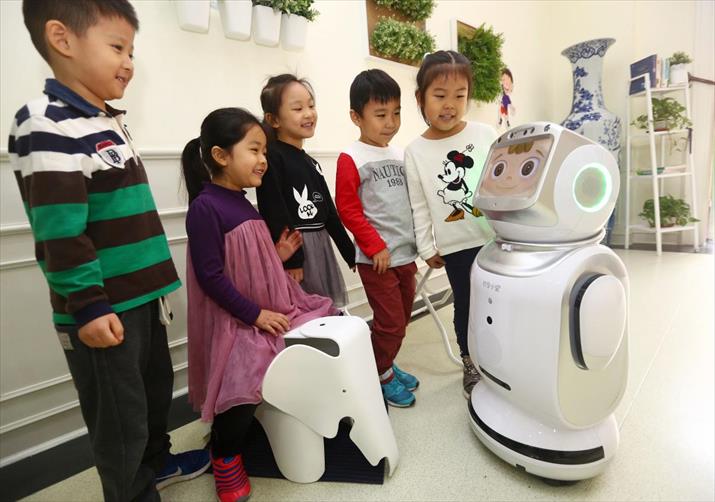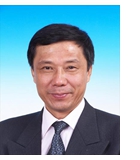| China |
| A Grand Plan | |
| China pursues further modernization in a choreographed approach | |
|
|
 Children in a kindergarten in north China's Tianjin interact with a robot "teacher" on October 12
(XINHUA)
 Socialism with Chinese characteristics has entered a new era, Xi Jinping, General Secretary of the Communist Party of China (CPC) Central Committee declared while delivering a report to the 19th CPC National Congress on October 18. He said that to realize socialist modernization is the overarching goal of developing socialism with Chinese characteristics. Socialism with Chinese characteristics has entered a new era, Xi Jinping, General Secretary of the Communist Party of China (CPC) Central Committee declared while delivering a report to the 19th CPC National Congress on October 18. He said that to realize socialist modernization is the overarching goal of developing socialism with Chinese characteristics.The report unveiled a two-stage development plan for the period from 2020 to the middle of the century: From 2021 to 2035, socialist modernization will be basically realized based on the foundation created by the moderately prosperous society; from 2035 to 2050, China will develop into a great modern socialist country that is prosperous, strong, democratic, culturally advanced, harmonious and beautiful. China's modernization process The modern history of China reveals that during the period from the Opium War of 1840 to the mid-21st century, China rose from humiliation and embarked on a road of national rejuvenation. In the century from 1840 to 1949, Chinese people, with unyielding spirit, engaged in a heroic and epic struggle to resist feudal rule and foreign aggression, and to gain national independence. They suffered excruciating pain, endured innumerous tribulations and made painstaking efforts. Under the leadership of the CPC, they founded the People's Republic of China in 1949. National independence and liberation paved the way for China's modernization and prosperity and laid political and institutional foundations for the realization of the Chinese dream. During the century from 1949 to 2050, the historical mission for China and Chinese people is to realize modernization and the Chinese dream of national rejuvenation. China accelerated its modernization process after the introduction of the reform and opening-up policy in the late 1970s. In 1987, at the 13th CPC National Congress, the late Chinese leader Deng Xiaoping put forward a three-step strategy for China's modernization. The first step was to double 1980 gross national product (GNP) and ensure that people have enough food and clothing. The second was to quadruple the 1980 GNP by the end of the 20th century. The third step is to increase the per-capita GNP to the level of medium-developed countries by the mid-21st century. Then the people will be moderately prosperous and modernization will be basically realized. In the two decades after the implementation of the reform and opening up, the first and second objectives were attained. During this period, China's economy grew in leaps and bounds, and hundreds of millions of people were lifted out of poverty. As China entered the 21st century, it began to strive toward its third-step goal, which is to realize modernization by the year 2050, and grow into a prosperous, strong, democratic, culturally advanced, harmonious and beautiful modern socialist country, and achieve national rejuvenation. In the first two decades of the 21st century, China continues to promote the socialist modernization, and further develop its socialist market economy so that people can enjoy a moderately prosperous life. Then, in the ensuing 30 years, the country will realize modernization in every dimension. A new era After the 18th CPC National Congress in 2012, China entered a decisive stage for completing the building of a moderately prosperous society in all aspects. After the 19th CPC National Congress, only three years remain for China to achieve this goal, hence this is a critical period. According to official estimation, by 2020 when China fully becomes a moderately prosperous society, its GDP will approximate 100 trillion yuan ($15 trillion), and its annual per-capita GDP will reach $11,000. Meanwhile, all people will have risen out of poverty. Permanent urban residents will account for more than 60 percent of China's population. Annual per-capita disposable income will range between 30,000 yuan ($4,523) and 35,000 yuan ($5,277). China's GDP will still rank second in the world, yet the gap between China and the United States, the largest economy in the world, will further narrow. China will remain among the upper middle income countries, but it will come to be one of the top countries in this rank. This will be the foundation for China to build on in order to overtake the United States to become the world's largest economy and a high income country after 2020. A basically modern socialist country In the report delivered to the 19th CPC National Congress, Xi pointed out that based on a comprehensive analysis of the international and domestic environments and the conditions for China's development, a two-stage development plan has been drawn up for the period from 2020 to the middle of this century. In the first stage from 2020 to 2035, China will build on the foundation created by the moderately prosperous society with a further 15 years of hard work to see that socialist modernization is basically realized. China will grow from an upper middle income country into a high income country. It will become the largest economy in the world, and basically achieve socialist modernization. By 2035, China's economic and technological strength will have increased significantly, and it will become a global leader in innovation. The rights of the people to participate and to develop as equals will be adequately protected. The rule of law for the country, the government and society will be basically in place. Institutions in all fields will be further improved. The modernization of China's system and capacity for governance will be basically achieved. Social etiquette and civility will be significantly enhanced. China's cultural soft power will grow much stronger. Chinese culture will have greater appeal. People will lead more comfortable lives, and the size of the middle-income group will grow considerably. Disparities in urban-rural development, in development between regions, and in living standards will be significantly reduced. Equitable access to basic public services will be basically ensured, and solid progress will have been made toward prosperity for everyone. A modern social governance system will have basically taken shape, and society will be full of vitality, harmonious, and orderly. There will be a fundamental improvement in the environment. The goal of building a beautiful China will be basically attained. A modern socialist country The report delivered to the 19th CPC National Congress stated that from 2035 to the middle of the 21st century—the second stage for transforming China into a modern socialist country, China will build on having basically achieved modernization, work hard for another 15 years and develop itself into a great modern socialist country that is prosperous, strong, democratic, culturally advanced, harmonious and beautiful. Looking ahead to 2050, there are five areas of focus as China moves to become a strong and modern socialist country. First, in the economic arena, by the middle of this century, China's GDP will more than quadruple that in 2020, ranking the largest in the world. It will become a high income country, and people will in general live a relatively affluent life. China will also become a strongly innovative country, listed among the world's top three most innovative countries. The value added of its tertiary industry will account for more than 70 percent of its total GDP. The permanent urban population will account for more than 70 percent of the total population. Urban and rural development, as well as regional economic development will be more integrated. The international status of the RMB will further improve, and it will become a reserve currency, and hence an international currency. China will also play a major role in global economic governance. Second, in terms of political reform, China will modernize its governance system and governing capability, and improve its socialist market economic system. It will complete the building of a comprehensive political system of democracy and the rule of law. The government will be innovative, service-oriented and law-based. Meanwhile, the modernization of Party building will also be completed. Third, in the area of social development, people will become well-off. Public services in urban and rural areas will be more equalized and education modernized. China will become one of the countries with the richest human resources in the world. Its per-capita GDP will be among the top in the world, and per-capita disposable income will reach a higher level. Its income will be distributed more equally and its Gini coefficient will stay in a relatively reasonable range. The coverage of social security will be universal, the society will be harmonious and stable, and China will rank high in the world in terms of social development. Fourth, China will become a culturally strong socialist country. The socialist core value system will be deeply rooted in people's hearts, and people will be better educated and society more civilized. A public cultural service system will be completed, cultural products will be more colorful, and the cultural industry's status in the tertiary industry will further rise. China will become one of the most culturally influential countries in the world. Fifth, China will have one of the largest green economies in the world. Its green development model and green lifestyle will develop further. Circular and low carbon economic systems will continue to improve. The impact of economic and social development on the ecological environment as well as the consumption of energy and other resources will be kept within the limit of the environment's carrying capability, so that the ecosystem can sustain and purify itself. China will make greater contributions to maintaining ecological security, mitigating global warming and promoting sustainable development. The author is a professor with the Party School of the CPC Central Committee Copyedited by Francisco Little Comments to zanjifang@bjreview.com |
|
||||||||||||||||||||||||||||||
|